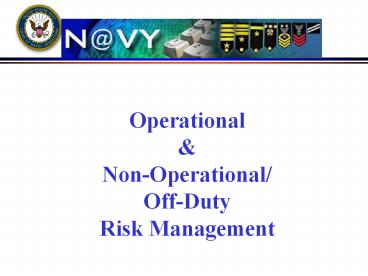Operational - PowerPoint PPT Presentation
1 / 46
Title:
Operational
Description:
1. Accept risks when benefits outweigh. costs. 2. Accept no unnecessary risk ... When Costs Outweigh Benefits. Leadership decision. Make Risk Decisions. 3. Make ... – PowerPoint PPT presentation
Number of Views:47
Avg rating:3.0/5.0
Title: Operational
1
Operational Non-Operational/Off-DutyRisk
Management
2
ORM Concepts
- All are responsible for using ORM
- Risk is inherent in all operations
- Risk can be controlled
3
ORM Will
- Increase probability of a successful mission
- Significantly enhance overall decision making
skills - Guide appropriate level decision making
- Cut losses significantly
4
ORM Myths
- ORM is an additional requirement
- ORM does not apply in war/combat
- ORM is rigid
- ORM will go away
5
ORM Principles
- 1. Accept risks when benefits outweigh
- costs
- 2. Accept no unnecessary risk
- 3. Anticipate and manage risk by
- planning
- 4. Make risk decisions at the right level
6
Step 1 - Identify Hazards
- Hazard A condition with the potential to cause
personal injury or death, property damage or
mission degradation.
7
Identify Hazards
8
Operational Analysis
- Specified implied task
- Bite-size chunks
- How was it done last time?
- Involve operators
- List in time sequence
- Prioritize significant events
9
List Hazards
- Preliminary Hazard Analysis (PHA)
- What If Tool
- Change Analysis
10
Brainstorming
- Useful technique throughout all ORM
- Free input (disciplined)
- Round-robin technique
11
Determine Root Causes
- Target root cause versus symptom
- Keep asking why until root cause is determined
12
Step 2 - Assess Hazards
13
Hazard vs. Risk
14
Assess Hazards
Action 3 Complete Hazard/Risk Assessment
Action 2 Assess Probability
Action 1 Assess Severity
15
Assess Severity
- Impact to mission?
- Impact to people?
- Impact to things?
- (material, facilities, environment)
16
Assess Probability
- Use the cumulative probability of all causation
factors - Express in descriptive or quantitative terms
- Use experience data when possible
- Acknowledge uncertainty
- Exposure
17
Risk Assessment Matrix
18
Assessment Pitfalls
- Over Optimism
- Misrepresentation
- Alarmism
- Prejudice
- Subjective Inaccuracy
19
Step 3 - Make Risk Decisions
20
Make Risk Decisions
21
Identify Control Options
- Begin with a Totem-pole List of Risks
- Generate a List of Potential Controls for Each
Risk - Get Operator Input
- Consider Control Measure Conflicts
22
Determine Control Effects
- Always choose the most mission supportive
combination - Find control options that enhance impact
- Get operator input
- Determine residual risk
23
Make Risk Decisions
- Benefits gt Costs?
- Accept The Risk
- When Benefits Outweigh Costs
- Reject The Risk
- When Costs Outweigh Benefits
- Leadership decision
24
Step 4 - Implement Controls
25
Implement Controls
26
Make Implementation Clear
- Effectively COMMUNICATE!
- Use Examples, Pictures, Charts
- Describe Successful Implementation
- Positively Sell Control Measures
27
Establish Accountability
- Accountable Person Approves Controls
- Clear Assignment of Responsibility
28
Provide Support
- Command Provide Personnel and Resources
- Design in Sustainability
- Employ Feedback Mechanism
29
Guidelines
- Integrate into Plans, Training, and Instructions
- Consider Control Measure Conflicts
- Test on Sample Group
30
Why ImplementationFails!
- Wrong control for the problem
- Its overmatched by other priorities
- Nobody measures until it is too late
31
Step 5 - Supervise
32
Supervise
33
Monitor
- Correct Implementation of Controls
- Changes requiring further ORM
- New hazards
- Mission task changes
34
Review
- Risks and mission balanced
- Effect of controls on mission
- Measurement of control effectiveness WRT Mission
Accomplishment
35
Feedback
- Document Lessons Learned
- Archive Documentation
- Local Files
- TRACS Total Risk Assessment and Control System
36
INTEGRATING OPERATIONAL OFF-DUTY RISK
MANAGEMENT IN YOUR COMMAND
37
Some Key Questions
- What is our Start Point?
- What are the Critical Steps?
- How Long Should it Take?
- Who is Responsible?
- How do We Know if Our Implementation is
Effective?
38
Integration Plan
Month 1
Month 2
Month 3
- Policy
- Training
- Application
- Measurement
- Accountability
39
Policy Statement
- Sample We must minimize training and combat
risks to acceptable levels through the continuous
application of ORM in all operational and
non-operational (off-duty) planning and decision
making processes
40
Visibility
- Conduct promotional blitz - posters, POD notes
and verbal comments at every opportunity - Submit ORM articles to local publications
- Modify SOPs, Instructions Anymouse forms and
briefing checklists to incorporate ORM
41
ORM Training
- ORM is incorporated in many of the existing
training tracks - Local Top-down training at the organizational
level - Modify existing training material at all levels
to include Operational and Non-operational/Off
Duty Risk Management
42
Time Critical ORM
- As personnel get trained, use Time Critical ORM
in every operation - Use High, Medium Low for Probability Severity
- The Four principles will be reinforced through
actual situations
43
Deliberate ORM
- Apply Deliberate ORM in Planning for Infrequent
Operations, such as deployment - Use a Mix of People Who are Comfortable with ORM
and Some Operators Who Have Just Been Trained - Use the Risk Matrix from the OPNAV instruction
44
Measurement
- Tracking Existing Measures for Mission
Accomplishment, Readiness and Safety - Look for Trends (up or down)
- Seek Assistance from Fleet Tactical Training
Groups in Developing Measures of Effectiveness
for ORM
45
Accountability
- Recognize ORM Application and Successes with
Letters of Appreciation, Safety Pro Awards and
Personal Awards - Incorporate ORM into qualifications and
certifications such as Watch standing, Warfare
Designation, etc. - Set Expectations for ORM Utilization and document
FITREPS Evals accordingly
46
Risk Management Flow Review































